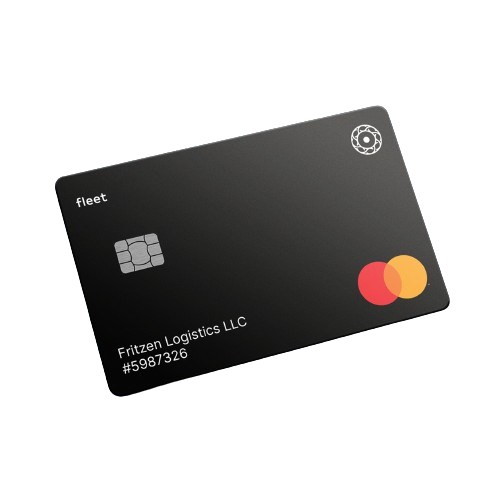In this guide, we’ll break down what fuel cards are, how they work, and how trucking companies can use them to their benefit. Keep reading to learn more.
What are Fuel Cards?
Fuel cards, also called fleet cards, help transportation companies save money, increase control over fuel purchases, and manage expenses efficiently. Fuel cards offer a range of benefits for both fleet managers and professional drivers, including:
- Up to 25¢ off per gallon on fuel purchases
- Route mapping to help drivers find the cheapest fuel on their route
- Fraud mitigation by blocking unusual fuel purchases
One highly recommended option for fleet owners is the Chevron Texaco gas card. This card provides extensive benefits such as fuel credits, participation in the Chevron Texaco rewards program, and enhanced fraud protection.
How Do Fuel Cards Work?
While most fuel cards strive to provide fleets with discounted fuel prices, it’s important to note that not all fuel cards are created equal. This means that different fuel card providers may have different processes.
Generally speaking, however, you can use your fleet fuel card in one of two ways:
- As a credit card – In this scenario, the fuel card acts and functions the same way that a credit card would. When at the pump, the truck driver pays for their fuel using the line of credit associated with the card. Then, the balance is later paid off, similar to a monthly credit card bill.
- As a debit card – In this case, a trucking company can add funds to their drivers’ prepaid fuel cards to help manage spending limits and keep fuel expenses in check.
{{CTA}}
Benefits of Fuel Cards in Fleet Management
The primary benefit of implementing the use of a fuel card is cost savings on fuel. However, because fuel cards are capable of more than your average credit or debit card, there can be other big benefits when implementing an effective fuel card strategy for your fleet.
- Expense tracking and management - Pay drivers faster with a centralized system that now only tracks fuel purchases, but mileage, loads, and driver hours.
- Increase control over driver spending - Set daily or weekly spending limits and hours, implement spend categories for non-fuel purchases, whitelist merchants, and manage card assignees.
- Paperless documentation – Manually monitoring your total mileage, total gallons purchased, overall fuel costs, and average fuel economy can be an incredibly time-consuming process. With a fuel card that monitors this information for you through an online account, you can streamline your paperwork and reporting procedures.
- Credit bureau reporting – A fuel card that reports your card payments to credit bureaus can allow you to build up your credit.
If you partner with a multi-service fuel card, you may be able to use your fuel card to pay for additional trucking-related expenses, such as 1:
- Truck repairs and maintenance
- Auto parts
- Insurance
- Tolls
- Wiper fluid and blades
- Motor oil
- Antifreeze
Security Features of Fuel Cards
Fuel cards also offer security features that protect your business from fuel card fraud.
- Telematics Integration to Validate Purchase Location - Connecting your fuel card to a telematics system can help you track fuel levels to ensure no non-employee vehicles are fueled. You can also block transactions that occur outside a vehicle’s vicinity or exceed its tank capacity.
- Driver Authentication - Enhanced authentication techniques ensure that only the assigned driver is the person using the fuel card. Depending on the fuel card provider you partner with, drivers may be required to provide their unit number, trip number, or truck driver number.
How Much Can You Save with a Fuel Card?
So, how much money can a fuel card help your trucking company save? The exact amount you can save will depend on a few factors, like:
- The partnerships the provider has with truck stops and merchants
- The discount program the provider has in place
- The distance your drivers travel and where they travel to
- The number of trucks in your fleet
- The specifics of the fuel card program
For instance, fuel card savings per gallon can be wide-ranging, some offer no discounts while other providers offer large discounts.
Yet, the most important aspect to consider with average savings is the number of participating stations where the gas card is accepted. Many times, fuel cards that offer much higher fuel price-per-gallon savings are usually only accepted at a few participating truck stops.
What to Look for in a Fuel Card
Putting together a strategy for implementing the use of a fuel card for your fleet can definitely be worth it. The discounts on diesel fuel alone are often enough to make fleet fuel cards a worthy investment.
However, to make a fuel card worth your while, you should make sure that you fully understand the details of your specific fuel card program. As we mentioned earlier, not all fuel cards are created equal, so they won’t all provide the same fleet card benefits.
To get the most savings out of your fuel card, look for a fuel card program that offers:
- Low fees – To increase your overall savings, choose a fuel card that offers low or no operating fees and has zero spending requirements.
- Setup fees
- Monthly fees
- Per-transaction fees
- ACH fees
- Overdraft fees
- Out-of-network fuel station fees
- Card replacement fees
- No limits on discounted gallons – Some fuel card providers limit your fuel discounts to the first 5,000–6,000 gallons 2. By choosing a universal gas card with no limits, you don’t have to put a cap on savings.
- Universal discounts – By choosing a card that can be used at any truck stop, you avoid paying out-of-network station fees or spending time trying to find an in-network fuel station.
- Savings on vehicle-related expenses – To stay on the road and on schedule, professional drivers need more than just fuel. Finding a fuel card that covers repairs, parts, insurance, and more leaves you with more cash on hand for other expenses, like employee payroll.
- Fraud protection – As stated earlier, fraud can cost your company hundreds of dollars. With fraud protection, you can ensure your money stays in your hands.
The good news is that a fuel card can be used by anyone, from an owner-operator to a single driver in a fleet of hundreds of trucks. So, once you find the gas card program that’s right for you, you can potentially start lowering your operating costs and increasing your profits.
{{CTA}}
Save More with AtoB—The Fuel Card That’s Accepted Everywhere
Now that you understand how fuel cards work, you may be on your way to finding the best fuel card provider for your business.
AtoB can help you keep your operating costs low and your drivers on the road for longer. Powered by Mastercard, our fuel card is accepted nationwide - that means you can even use it at local small business mom-and-pop fuel stations. Plus, our card covers other truck-related expenses, including repairs, parts, tolls, insurance, and maintenance.
There’s no need to provide a credit score and there’s no limit on the amount of discounted gallons you can benefit from. You can even set specific spending limits and track all your drivers' transactions through our customizable dashboard.
Purchasing fuel and managing your fleet has never been easier with AtoB. Unlock your potential savings by choosing the AtoB fuel card today.
Sources
1 US General Services Administration. GSA Fleet Cards. https://www.gsa.gov/buying-selling/products-services/transportation-logistics-services/fleet-management/vehicle-leasing/gsa-fleet-card
2 AtoB. https://www.atob.us/
Get started with AtoB

Reviewed by
Vedant Khamesra is the driving force behind product management at AtoB. Specializing in strategic partnerships, SMB solutions, and new product development, Vedant seamlessly navigates P&L responsibilities while leading product execution and strategy. He is fueled by AtoB's mission to empower truckers and fleets with intelligent financial tools and services, making their lives easier and more rewarding.
Start saving today


